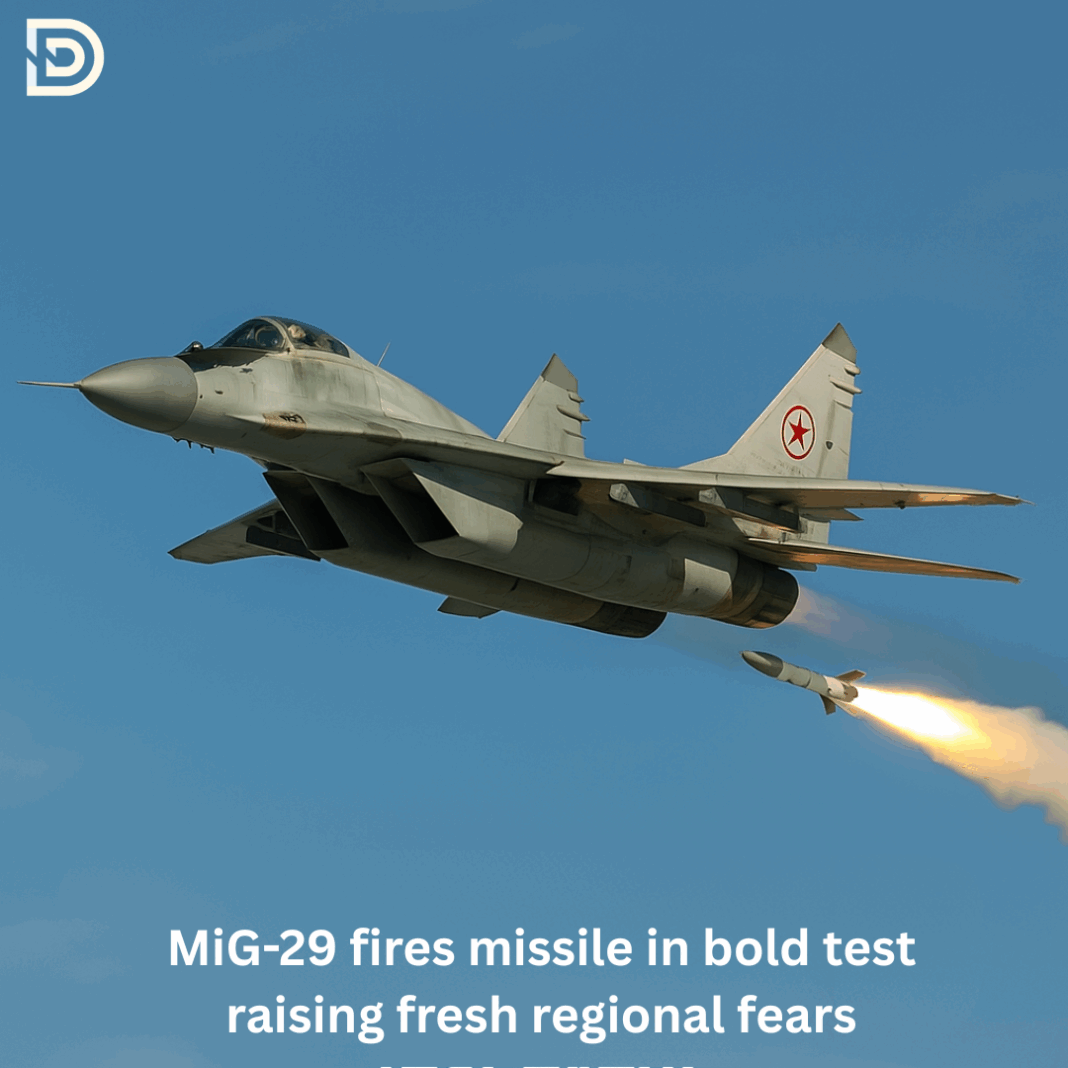On May 17, 2025, North Korea unveiled a new active radar-guided air-to-air missile integrated with its MiG-29 fighter jets.
North Korea’s Missile Breakthrough and MiG-29 Integration
The missile was fired from a MiG-29 platform during the display, which was part of Kim Jong Un’s tour of the 1st Guards Air Division. This development marks a significant departure from North Korea’s historically outdated air-to-air systems and suggests a new direction in its military aviation strategy.
The missile, with an estimated range between 90 to 120 kilometers, uses active radar guidance, enabling it to engage targets beyond visual range (BVR). Previously, North Korea’s MiG-29s were limited to older systems like the infrared-guided R-60 and semi-active radar-guided R-27 missiles. The newly revealed missile resembles foreign designs such as the U.S. AIM-120 AMRAAM and China’s PL-12, although Pyongyang maintains that the latter is made in its own country. Images released through state media show Kim Jong Un inspecting both the missile and a selection of precision-guided air-to-ground weapons, indicating broader aerospace ambitions.
Originally developed in the Soviet Union in the 1970s, the MiG-29 remains North Korea’s most powerful aircraft. Approximately 35 to 40 MiG-29s—variants including the MiG-29 9.12B and MiG-29S-13—are currently operational in the country. These jets, stationed mainly at Sunchon Airbase, are powered by twin Klimov RD-33 turbofans and can reach speeds of Mach 2.25. Despite their powerful engines and robust design, the aircraft’s original radar systems and avionics, such as the N019 Slot Back radar and infrared search and track (IRST), are now considered outdated by modern standards.
U.S. Technology Fuels North Korean Missile: 116 U.S.-Made Parts Found in Deadly Kyiv Strike
Modernization Amidst Aging Fleet and Sanctions
For decades, North Korea’s air force has struggled with obsolescence, largely due to international sanctions and the end of Soviet support. While the Korean People’s Army Air Force (KPAF) maintains over 400 combat aircraft on paper, many are not flight-worthy. Reports suggest that pilot training remains limited, averaging only about 15 hours of flight annually.
North Korea has compensated for its outdated fighters by investing heavily in surface-to-air missile systems. The KN-06 (Pyongae-5), a long-range SAM comparable to Russia’s S-300, became operational in 2017 and reflects Pyongyang’s asymmetric defense approach. However, the introduction of a modern BVR missile for its MiG-29s marks a shift in doctrine—one that emphasizes longer-range air engagements and boosts its ability to challenge South Korean and U.S. air patrols near its borders.
The operational use of this missile, however, faces technical hurdles. The MiG-29’s 1980s radar may not fully support the advanced features of the new missile, particularly in a contested electronic warfare environment. Unlike the U.S. F-35A Lightning II or F-22 Raptor—both used by South Korea and the U.S. in the region—North Korea’s aircraft lack stealth, sensor fusion, and data link capabilities, placing them at a tactical disadvantage despite the missile’s capabilities.
South Korea on High Alert After North Korea Launches Missiles and Sends 15,000 Troops to Russia
Speculation persists regarding external assistance. The missile’s resemblance to foreign systems has led analysts to suspect technical support from Russia or China. Notably, reports from December 2024 claimed that Russia had consented to provide North Korea with MiG-29 and Su-27 jets in return for troop deployments to support Russia’s operations in Ukraine. These aircraft, while older, could expand the KPAF’s operational scope and further integrate the new missile.
Regional Implications and Air Power Competition
This missile development has raised concerns in South Korea, Japan, and the U.S., all of whom closely monitor North Korea’s air force improvements. South Korea, in parallel, is advancing its Long-Range Surface-to-Air Missile (L-SAM) system, investing over $1 billion to strengthen its air defenses against North Korean ballistic threats. Meanwhile, North Korea reported testing a new anti-aircraft missile in March 2025, suggesting parallel development paths in both offensive and defensive aerospace capabilities.
South Korea operates over 60 F-35A stealth fighters and other modern aircraft like the F-15K and KF-16. With F-35s, F-16s, A-10s, and airborne early warning systems like the E-7 Wedgetail, the United States continues to have air superiority in the area. North Korea’s MiG-29s and possible Su-27s do not yet have the better sensor coverage and data-sharing capabilities that these systems give the allies to carry out surveillance and combat operations.
Nonetheless, the presence of a long-range air-to-air missile on North Korean jets complicates allied air operations, especially reconnaissance flights near its airspace. South Korea and the U.S. may need to recalibrate electronic warfare tactics and aerial engagement protocols to account for the extended reach of these new missiles.
Japan is also on guard, positioning its upgraded F-15Js and F-35s to thwart any aircraft provocations from North Korea. Historically, North Korea has conducted missile tests over Japanese territory, and the new missile raises the potential for further airspace tensions.
North Korea Escalates Tensions with Powerful Missile Test Amid Global Concerns
Despite this leap in missile capability, North Korea’s ability to mass-produce or maintain advanced airframes remains limited by sanctions, technological bottlenecks, and a struggling economy. The true operational impact of the new missile will hinge on whether North Korea can keep its aging jets flying, train its pilots effectively, and maintain the necessary logistics to support BVR warfare—a task that remains formidable under current conditions.

